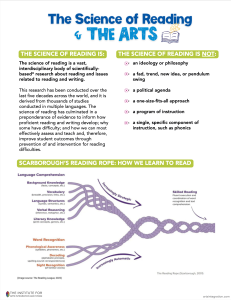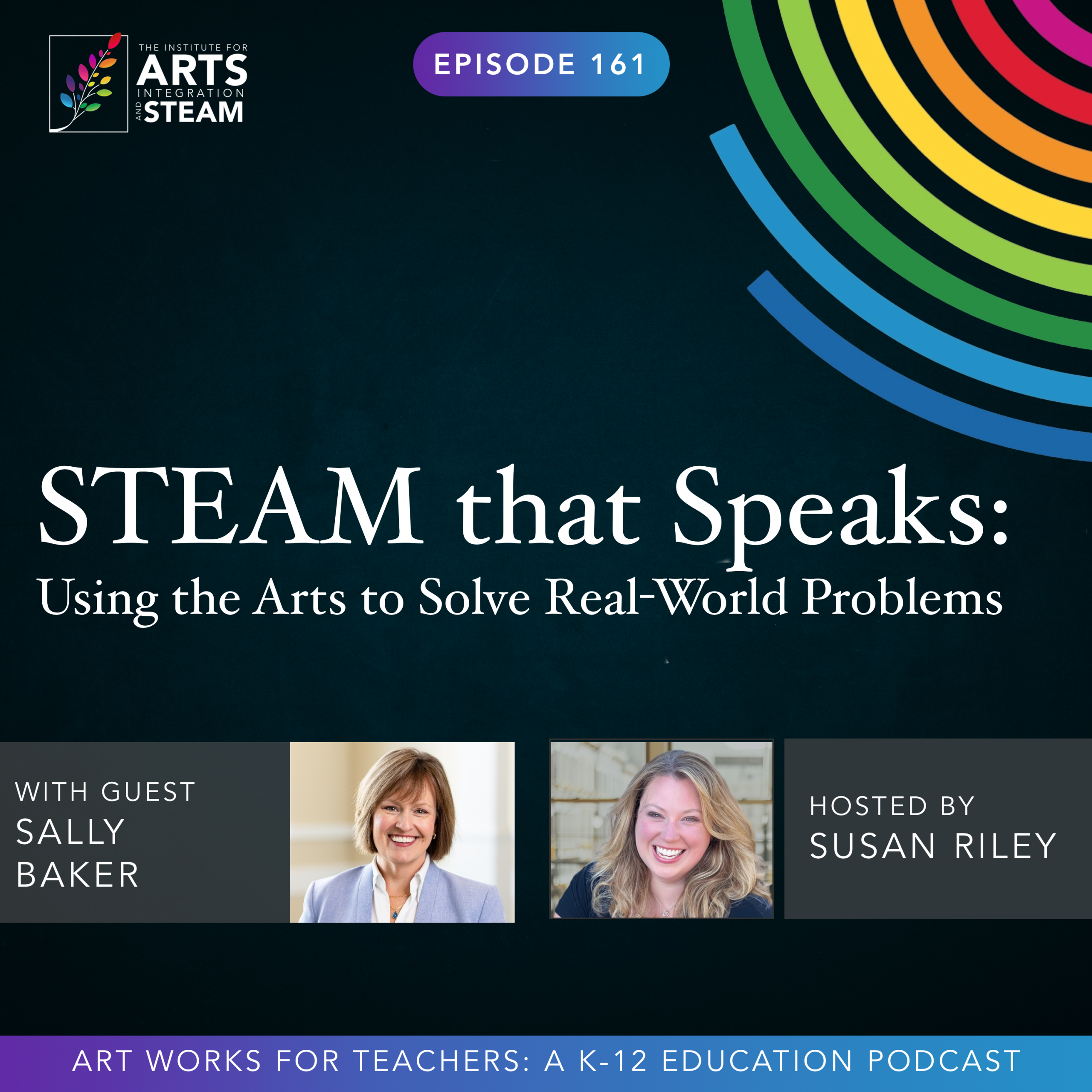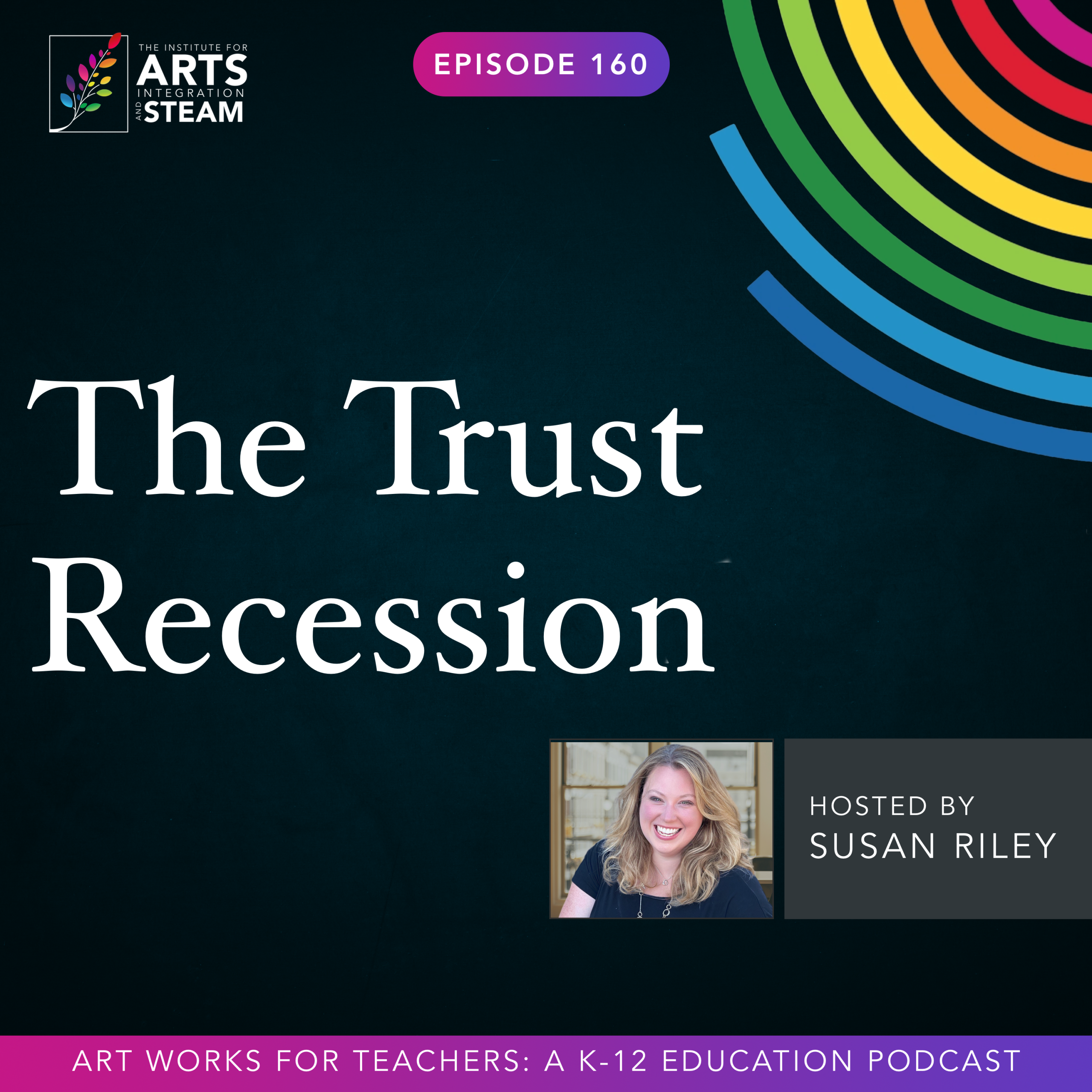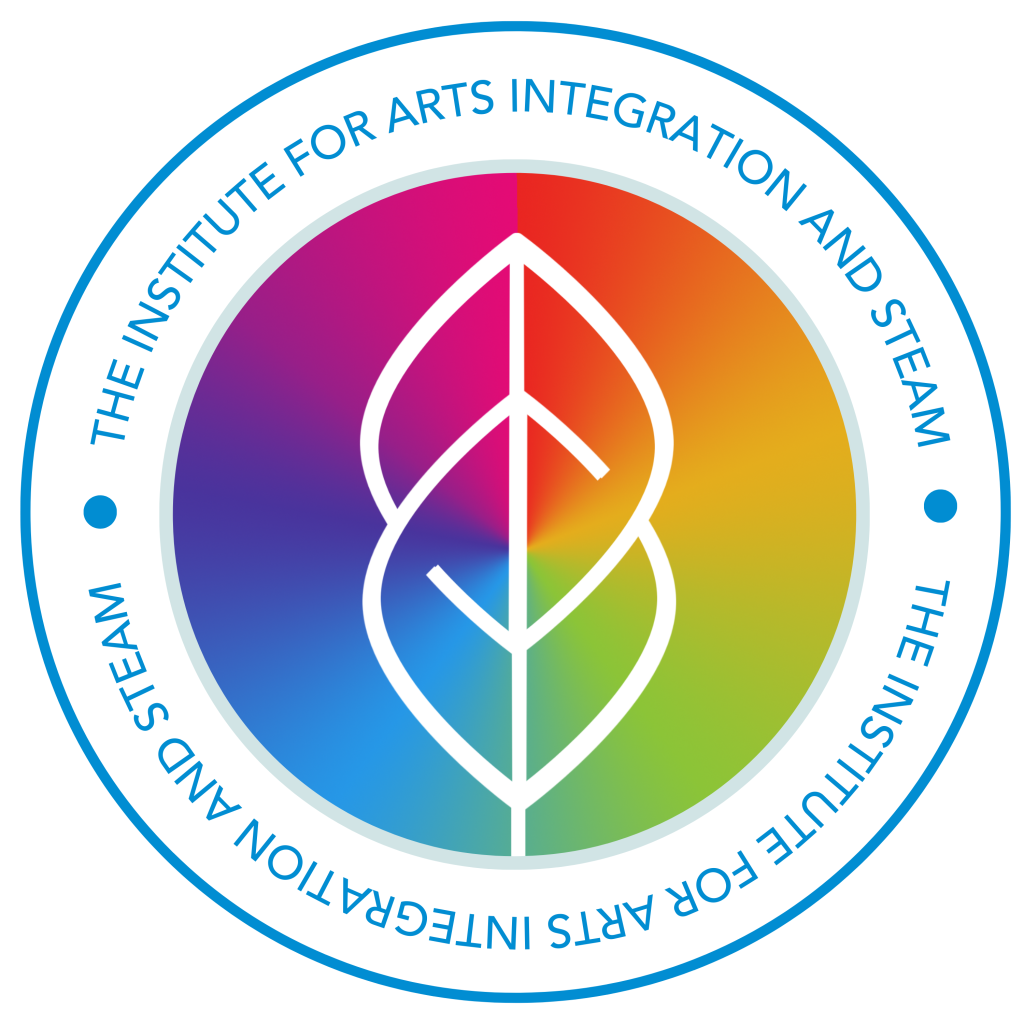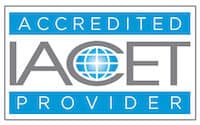ART WORKS FOR TEACHERS PODCAST | EPISODE 128 | 30:56 MIN
The Science of Reading & the Arts
The Science of Reading is backed by decades of research, yet much of it has remained disconnected from classroom instruction… until now. In this episode, we break down what it is, what it isn't, and why it's gaining momentum in schools. Whether you're a teacher, administrator, or arts educator, let's explore how we can help all children become learners who don't just learn to read but read to learn.
Enjoy this free download of The Science of Reading & the Arts resource.
Susan:
All right, hi, Kari, I'm so glad you're here with us today.
Susan:
So glad to be here, Susan. Thanks for the invitation.
Susan:
Of course, of course. So I am so excited to dig into the science of reading with you. But I before we begin, can you just share with our audience a little bit about yourself and the reading league?
Kari:
Yeah, absolutely. So my name is Kari Kurto. My current role is the National Science of Reading Project Director at the Reading League. We are a national nonprofit organization and our mission is to advance the awareness, understanding and use of evidence aligned reading instruction. And by evidence, we mean a reading instruction that aligns with the decades of research that have been studied and published on how kids learn to read.
Prior to this role, I worked at the Rhode Island Department of Education. And prior to that, I worked at a high school for students with learning differences, teaching teenagers to read often, you know, for the first time in their lives. And those kiddos taught me a lot. And I have them on my shoulders all the time.
Susan:
I love that. And then that's such a teacher's heart. So let's dig into the science of reading because I think this is something that it's coming down the pike for all teachers. We got to know about it. So I would love your expertise today to share a little bit about what the science of reading is and why it's important for all of us to understand.
Kari:
Well, it just so happens to be one of my favorite things to talk about. So I'm glad to. I'm actually going to share my screen if that's all right. And I'm going to start out with a resource that the Reading League has. And it's called the Science of Reading Defining Guide. And that's something that anyone can download the ebook for free. You can also order hard copies if you are interested. And it goes through exactly that because there's a lot of misconceptions out there about the science of reading. So this is the PDF of this resource. And again, we'll start with what the science of reading is not because I'm sure that a lot of your audience members being in school have heard some of these misconceptions.
So the science of reading is not just a philosophy. It's not a new idea. You'll see when we look to the definition that research has been conducted for 50, 60, sometimes people even say 70 years. So this is not a new thing. It's just new that this knowledge is being brought into the educational space in such a big way.
It's not a political agenda. Some folks say that this is strictly a conservative moment. And I'll tell you I am a very liberal human. And that is absolutely not true. So it is something that is across all political spectrums. It's not a one-size-fits-all approach. It's not a program.
So if you have programs or curriculum companies or for-profit companies that are calling you and saying, hey, by my product, and you could do the Science of Reading, that is not right. It's not a program. Can I have a program that's aligned to the science? But you cannot have a program that is the science of reading. And it is not a single component such as phonics. So a lot of the misconceptions are around the fact that the science of reading is just about phonics. It's not true.
We take into account the full scope of the research on what it takes to learn to decode the words on the page and to develop robust language. So that when kids read the words, they know what it means. So let's go into what the Science of Reading is. I won't read the full definition, but I'll just highlight some. And for those of you, like myself, whose eyes are getting a little questionable, they get a little bigger.
The Science of Reading is a vast interdisciplinary body of scientifically-based research about reading and issues related to reading. And some important key points here is that this has been, this research has been conducted across five decades, it has been conducted in multiple languages across the world. And it's culminated in a preponderance of evidence. And that evidence has developed certain consensus about how kids learn to read.
Susan:
Amazing. So in terms of, let's talk a little bit about why this is so important right now. Like why is the Science of Reading now? And why hasn't this come about in the last, I don't know, 50 years since it's been been recent?
Kari:
It's been a widely held secret, right? The research has been conducted, and it has been published in scientific journals. However, traditionally in educator preparation programs, we, and I say we, because I'm talking about myself, I am still paying those student loans for my degree that I received that was firmly based in something called balance literacy. We did not receive a lot of the scientifically based research on how kids learn to read. So there's a great resource that I point folks towards. And this is something that I'll talk about later, that the reading league developed. It's a resource called the Reading League Compass. And it provides direction for all of these stakeholder groups.
And so what I'm doing is I'm on this administrators page right now. And on the administrator page, it's also on the Educator Preparation page. Down here, we have a link to this article. It's called the Structure Literacy Approach and a Typical Literacy Approach. And this is by the amazingly brilliant Louise Spears Swirling. And she articulates some of the differences between what has traditionally been taught in educator preparation programs and what we are learning to shift to. So when I was taught how kids learn to read, I was taught about developing these cozy corners and making sure we give kids like materials that they're motivated to read, which there's absolutely a place for all of that. I was also taught about workshop models where you give just a little bit of instruction and then you kind of let the kids discover the learning on their own.
This may work for some students, but come to find out it does not work for many and all of students. So this is about language comprehension and not necessarily digging into those big words and that background knowledge and those higher level concepts. And it's also about word recognition.
There's a podcast by Emily Hanford called Soul the Story that talks about this idea of teaching foundational reading skills and using something called the Cuing Approach, which has traditionally been taught in ed prep programs and is consistently in a lot of instructional materials. It's being taken out now, which is exciting, but it's this, she calls it a wrong idea of how kids learn to read where they use context cues and pictures to actually learn to decode the words. And that's actually how poor readers read. So it's important because of Emily Hanford's work of because of COVID, a lot of parents saw the way their kids were learning to read or not learning to read and were shocked honestly and started asking questions and digging in.
It also comes from a movement that started with families of kids with dyslexia because they're the canaries in the coal mine. They are really the ones that need this explicit, systematic instruction and practice in all of the foundational decoding skills in order to crack the code. So because of all of these elements that kind of converged and came together, there's now been an understanding of like, wow, we should probably learn about this peer reviewed research on how kids learn to read and make sure that our materials and our instruction align with that research. And we should also probably make sure we should get rid of these practices that are misaligned, that are inadvertently leaving kids behind and not developing skilled reading among many of our kiddos.
Susan:
Yeah, I know that some states are actually going as far as banning the use of queuing because it's so detrimental for some. So can you share a little bit just some highlights about what are some key differences between the science of reading and the reading methods we've used in the past?
Kari:
Yeah, absolutely. So this chart is a great place to anchor your understanding. I'm also going to share a resource that we have from the reading league because I'm gonna buzz down and I'm gonna show you. This resource is grounded in this scientifically based research. So if you look at our reference section, every single reference here is, you know, this meets the criteria of scientifically based research or meta analysis.
So I'm not expecting your audience to be as nerdy as I am and go through and read all of this. That's like fun for me, but not for everybody. So what we've done is, you know, we've read the research, we've done our best to understand the research and uplift those practices that both align and do not align to the scientific research. So you'll see, for example, we'll start with word recognition and I don't want folks to think that the science of reading is all about word recognition or all about queuing versus phonics, but because that is the loudest voice in the national conversation, we do start there and understanding that these practices here have been integrated into a lot of instructional materials. These are the red flag practices. These are the practices that don't align to the science of reading. So using the three queuing systems as a strategy for decoding, right? We can use queues to confirm the meaning of words once it's been accurately read, but to teach kids how to crack that code, we're changing the structure of their brain, which is just remarkable. It's such hard work and that's why you see kids struggle, but it's a good struggle, right? We need them to learn it explicitly, systematically practice to automaticity. There's no shortcuts, right?
Kari:
Because we want to develop this process called orthographic mapping and this is the way of doing it, right? We don't want to use queues. We don't want to ask kids to memorize the shape of words. We have a new section on our English learners emergent bilinguals website where we uplift a keynote that we had from Dr. Stanislaus DeHon and he explains this very well. In order to create this new part of our brain, what he calls the brain's letter box, we need that explicit systematic understanding that words are made of these individual sounds, those sounds connect to letters, you blend them together to create a word, and then you attach that word to the meaning that it has in your mind. So that's the science behind it.
So some of these things for word recognition, we were asking kids to memorize whole words, we weren't using queues instead of decoding, we weren't using systematic scopes and sequences, we were just kind of giving them a little bit of phonics decoding, maybe not integrated with spelling, which is also really essential. And now we know the importance of doing all of that together. We know the importance of fluency, which is another section, and here are some other differences with language comprehension.
We don't want to, especially in the early years, we don't want to see that workshop approach that just has student choice, implicit, incidental learning. We want to really have high expectations of our kids, we want to expose them to rich vocabulary, we want them to have read aloud with complex syntax, and that's where our librarians come into play. That's where all these amazing, the content that we're learning in art comes into play, and I'm giving a little bit of a spoiler, right?
But traditionally, with these leveled texts and being a reader, those early stage books, we're not developing that complex syntax understanding, we're not developing decoding, because these are words that they have to guess at. So really, it's now we understand that it's a healthy diet of teaching them, matching sounds to symbols to decode the words, practicing with decodable passages and decodable texts that are strictly for practicing that decoding skill, and exposing them to that rich language background knowledge, complex syntax so that they have these robust vocabulary and will be able to understand complex language once they can crack the code on their own.
Susan:
Amazing, I mean, this is exactly where we need to be. I think I've just, I've watched so many students struggle in the last 15, 20 years with reading, and I think so much of that could have been avoided if we were working within the science itself. So I'm such a big proponent of it. I'm so glad that this is finally coming out, and because it's part of our wheelhouse, and I truly believe that literacy expands beyond just one set of areas, right?
I think literacy is all encompassing. How can the principles of the science of reading be effectively integrated with the arts to enhance student learning outcomes?
Kari:
Yeah, well, I couldn't agree with you more. I mean, the more hands-on deck that we have, the better chance that our kids have of developing skilled reading. Kids come into school with different levels of language. Perhaps they are new to learning the language of instruction. They spoke a different language. Perhaps they spoke a different dialect at home. And so I'll start out with something that I think everybody can agree with. The more language and knowledge that we build across the day for our kids, that's the same or similar that can just really build that robust knowledge so that they can engage in conversations and deep thinking and build language the better. So that, I think, first and foremost, is a way that everybody can get together. What are you learning in the Tier 1 setting? How can you integrate that into your other United Arts classrooms? What are you learning in your United Arts classrooms? And how can you integrate that knowledge into your Tier 1 classroom? It takes talking, it takes collaboration, but at the reading league, we have a hashtag called, it takes a league, and we mean that globally and nationally, but also as a school, the schools that have, had really effective outcomes are the ones where it really is a school-wide culture and approach to developing language and literacy. The thing where other schools may not yet be talking about is how all settings can help students crack that code, that can help them with decoding strategies. And I think there's opportunities in United Arts settings to do that as well.
So while I was at the Rhode Island Department of Education, I put the call out one summer. I think it was the summer of COVID to United Arts teachers. And I was like, calling all teachers, I have this crazy idea, and would anybody be interested in supporting this idea of connecting the science of reading to special area instruction? And I had some friends come and join me. I had a couple of PE teachers, which was so exciting. I had a few music teachers. I had several art teachers, and all my friends, the librarians, came out in force. Can I tell you, I love you all, and I appreciate the time that we spent together if you're listening from Rhode Island, a big shout out to you. So we kind of came together, and we had a little mini training of what is the science of reading. And here's a bunch of aspects of the science of reading. This is what we understand about how kids learn to read. These are a couple of theoretical frameworks that help you understand those buckets that we need kids to be able to be automatic with lifting the words off the page called decoding.
And we need them to have a robust language system without either then reading comprehension is going to be affected. And we also have the reading rope here. This is a visual metaphor that helps us understand what goes into skilled reading. So any of these aspects that you can integrate into your United Art setting, or talk with your tier one teachers, talk with your coaches, your special educators, as to like being creative and seeing how you might be able to strengthen these strands of the rope, these upper strands are for developing language. The lower strands are for developing decoding skills. And working together, that's how our kids become skilled readers. For some, it's easier than others. And we also always have to think about our English learner students who may not have much of this in the language of instruction, but they probably have a lot of it in their home language. So how can we leverage that as an asset to integrate into our settings? I know I'm throwing a lot at you, sorry.
Susan:
No, this is so good.
Kari:
So again, we have some principles of what you could potentially do to help with decoding, breaking those words into sounds, fortifying student understanding of spelling, articulation, looking at their mouth shapes and how they're articulating the phonemes. The phonemes are those single word sounds. So connecting a words morphology and spelling. Now this may be a new word to some people. I love morphology. Our language is, here's another big word.
Are you ready for it? Morphophonemic. It means that our words are made of sounds, right. Like cat is made of cat, blend it together, cat. And then we attach it to the meaning of the thing that we know. There's also more themes in words. So we're talking about prefixes, suffixes, and base elements. And so that affects how a word is spelled, spoken. If students develop an understanding of both the phonology, those words and how to blend them together, the sounds and words how to blend them together, and morphology, these little meaning units, like invisible in meaning not, vis meaning to see, able, meaning able to, not able to see, right? If they develop an understanding of both of those elements, then they're going to have a deep understanding of words, and it's going to help their decoding and their language comprehension. So if you have a word nerd at your school, oftentimes your speech language pathologist, your reading specialists, think about those words that you're teaching in your content areas. Can you break them down by morphemes? Can you break them down by phonemes? Can you ensure that students know how to read them, spell them?
Sometimes these cool words in content areas, I'm thinking about art and music in particular, have a really interesting history too. So don't just teach the history of the content, teach the history of the word along with it. There's really rich history in our words. So those all help support decoding skills, and then these all help to develop that like those language comprehension skills. I know I'm taking a long time to describe this, so let me just buzz down and show the good part here, right? So we've got exercises that friends can use, friends, that's usually what we say students. My colleagues at United Arts Teachers can use in their settings. So for art, we have some really great exercises. I like this one. I was looking at one earlier on page 17. So we're talking about the language of art, and when you're using language, you can actually, and developing this background knowledge if you use note taking templates, sentence frames, to help build their use of higher level language and more complex sentence structures. You can do that. I think I have one on page 23 was it that does talk about morphology. Is this the one? So for example, kiln is a word that I heard from my art teachers that was often misspelled. And so if you look into the history of that word, then it actually comes from Latin kulina, which means a kitchen or cooking stove. And so if you teach the history of that, you can see that it comes from kulina, which is like culinary, and that will help them understand that it's spelled with an N and not an M. Does that make sense?
Susan:
Yes.
Kari: There's also lots of great activities for those who teach library. Again, librarians and libraries are just such wonderful spaces for developing vocabulary, background knowledge we have. We connect it to coding. My son is a big coder. So of course I had to have one on coding. Understanding text structures is something that librarians sometimes do, and that's so valuable. The science of reading shows that understanding text structure and those corresponding signals is really essential for students. So some of these things you may be doing already and not understanding that how much research supports that. We can also do things where we are thinking about the alphabetic principle, phonemic awareness and phonics, where you can start thinking about how to break some of those words down into sounds. Let's say we're teaching green eggs in hand. All right, friends, let's talk about the phonemes in each word, green.
G-e-n. How do we spell it? G-r-e-the-e sound is spelled with two, e's here. E-e-n. And you can break each word down into phonemes. You don't have to, but if you are working with a special population with kiddos that may need additional support, maybe students with language-based learning differences, this is just a little something that you can do in your setting to help them if they are still a kiddo that is working on developing accurate word reading.
I also do wanna take a moment to talk about decodable texts. I can't remember if we actually included this or not.
There's a lot of librarians associations that I've heard come out against the science of reading because they think that it's all about phonics and decodable texts. Decodable texts are texts that are aligned to the phonics, gopens, sequence that are is being taught in the classroom. And it's just like learning sheet music when they're playing the piano. You wanna practice with the notes that you know, right? And so for decodable texts, these are really great options for early readers to be able to take home practice with their families to practice in their tier one setting, maybe with their reading specialists because these are words, they contain words where kids have learned the phoneme graphing associations. They've learned short A, so it's gonna have a lot of short A sounds.
It's not leveled texts, leveled texts have lots of words with kind of random sound simple associations. If they haven't learned it, then they have no choice but to guess. And we don't want kids to guess at words because that's how poor readers read. We want them to develop that process of really being able to map that word in their brains. So this doesn't mean let's get rid of books and let's only have decodable books. My goodness, no, no, no. But if we're thinking about what books should kids take home to practice decoding specifically on their own, that's the role of decodable texts. All of the other books are developing the empathy and knowledge and vocabulary for our students. We want them to still be, have them be read to them, have them follow along with you. It teaches them so, so much, but I just wanted to clarify that for a moment.
Susan:
I think all of that's super important. And I also want to clarify a little bit for our arts educators who are in the audience. I don't think anybody is suggesting that an arts teacher specifically teach reading during their arts time. What I love about this packet, this is how I originally found Kari, because I found this resource and I was like, where the heck has this been? All of our life to connect the arts and the science of reading because this packet shares arts integrated lessons that you can start to use. It's also, I think, shares how simple things can be done within the arts classroom that also complement and support the science of reading, which I think is what we're all trying to do here. Things like vocabulary or word walls, I think, even just being able, everybody has vocabulary in your content area. Post your vocabulary onto the walls and see if there's connective words across content areas even to start having those conversations and dig into that vocabulary and understanding the origins of the word. I love that example. It's super simple. It's easy to do. It's not taking up a ton of your time, but it has a tremendous impact, I think, on all of our learners as they're working on their reading skills.
Kari:
That's right. And what has the biggest impact is the communication that's going to help among teachers within a school, right? It takes a league. You're in it together. How can you collaborate to advance your literacy outcomes?
Susan:
Exactly. Before we go, because we are almost out of time, I would love if you could just share, what are some resources or PD opportunities that the reading league has that our audience might be able to dig into some more?
Kari:
Yeah, well, it's all mostly on our website, thereadingleague.org. We are a non-profit, so we have a lot of no-cost resources. We have the defining guides, the curriculum evaluation guidelines, the reading league compass that I shared earlier. We also have, for those of you who teach littles, a children's television show called Reading Buddies that has episodes for free on YouTube, and it's also on some PBS stations across the country. We also do have school-based partnerships, so the reading league will go in and work with, they'll begin the conversation with administrators, make sure that they know that this is a big effort to undertake. It is worth it, but it's a relationship that the reading league starts. It's not just a one-and-done PD, and we work with schools and districts and continue to work with them for years to help them build an evidence-aligned system.
Susan:
Amazing. Well, thank you so much for joining us today, Kari, I am so excited about all of the possibilities that this has for all of our students and for us as teachers, and so I'm grateful that you were here and could share your experience and the impact of this with our audience.
Kari:
It's an honor and a thrill, and I would love to hear if anybody uses these. If you would like to share any success stories, please share my email address, just kari@thereadingleague.org. Perhaps the reading league could take this and make it a little bit larger in future years as a project, but I would love to hear from you connect with you, and thank you for the opportunity to share.
Susan:
Absolutely. All right, thanks, Kari.

